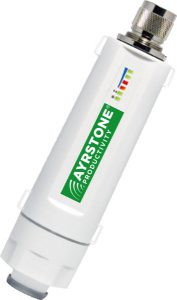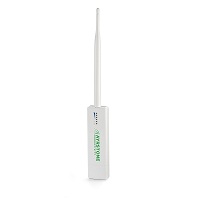![]() We are pleased to announce the new AyrMesh® Hub2T.
We are pleased to announce the new AyrMesh® Hub2T.
The AyrMesh Hub2T is a direct replacement for the Hub2n, but with some important differences. It meshes with the Hub2n and any other AyrMesh “Hub2” products.
First off, the Hub2T is a lot bigger than the Hub2n, with a much bigger antenna and a tougher stainless steel mounting bracket. The bigger antenna improves the performance of the Hub, while the new bracket just makes the entire Hub more stable and reliable, whether it is mounted on a pole or a flat surface.
Paradoxically, the new Hub2T has a little less radio transmitting power (about half a watt vs. almost a watt for the Hub2n), but it performs better than the more powerful Hub2n. Why? That big antenna! Reducing the transmitting power allows us to use twice as powerful an antenna, and (at least to a degree) a higher-gain antenna is better than more transmitting power. Power allows the Hub to “shout” longer distances, but a higher-gain antenna enable the Hub to both “shout louder” and “listen better” – resulting in better overall performance.
 The other interesting change is the addition of a “gland” on the bottom of the radio. This gland makes it a bit trickier to install the Hub, but it protects it from water splashing up from below. This addresses concerns we have heard from some livestock operators who want to put Hubs near livestock pens or in milking parlors or farrowing houses, but worry about having to spray water around the Hub. We still don’t recommend spraying water directly up at the Hub, but this Hub will better withstand inadvertent sprays of water from below.
The other interesting change is the addition of a “gland” on the bottom of the radio. This gland makes it a bit trickier to install the Hub, but it protects it from water splashing up from below. This addresses concerns we have heard from some livestock operators who want to put Hubs near livestock pens or in milking parlors or farrowing houses, but worry about having to spray water around the Hub. We still don’t recommend spraying water directly up at the Hub, but this Hub will better withstand inadvertent sprays of water from below.
The Hub2T also uses less power than the Hub2n, so it is better for solar-powered field installations – if you have experienced “dropouts” in winter due to low batteries on the solar system, the Hub2T will work better (although that may also be a sign you need to replace those batteries…)
Should you replace your Hub2n with a Hub2T? In most cases, no – you’re not going to see enough of a difference in performance to make it worthwhile. The only exception is where there is a danger of water splashing up from beneath the unit.
But, if you are just starting your AyrMesh network, and as you expand, the AyrMesh Hub2T will be a low-cost, no-hassle workhorse, whether it’s on a building or out in the field.

 I have a Google Alert for “Wireless Farm” – I get about an article a week (and many of them are about wireless technologies for “server farms” and other odd things). But today I got a link to this article about “
I have a Google Alert for “Wireless Farm” – I get about an article a week (and many of them are about wireless technologies for “server farms” and other odd things). But today I got a link to this article about “ As you know, I think that the “Internet of Things” (IoT) has enormous potential for the farm. But we have all been recently reminded of the problems we are facing as BILLIONS of new devices come on to the Internet – Friday October 21, the IoT literally broke the Internet.
As you know, I think that the “Internet of Things” (IoT) has enormous potential for the farm. But we have all been recently reminded of the problems we are facing as BILLIONS of new devices come on to the Internet – Friday October 21, the IoT literally broke the Internet.

 This is another example of the kind of technology that is available at very low cost when you outfit your farm with an AyrMesh network – each field can be outfitted with a FarmMap gateway device to communicate with their soil sensors, and you can connect the gateways to AyrMesh components (Hubs, Receivers, or Bridge radios, depending on your network) to connect them to your network.
This is another example of the kind of technology that is available at very low cost when you outfit your farm with an AyrMesh network – each field can be outfitted with a FarmMap gateway device to communicate with their soil sensors, and you can connect the gateways to AyrMesh components (Hubs, Receivers, or Bridge radios, depending on your network) to connect them to your network.













